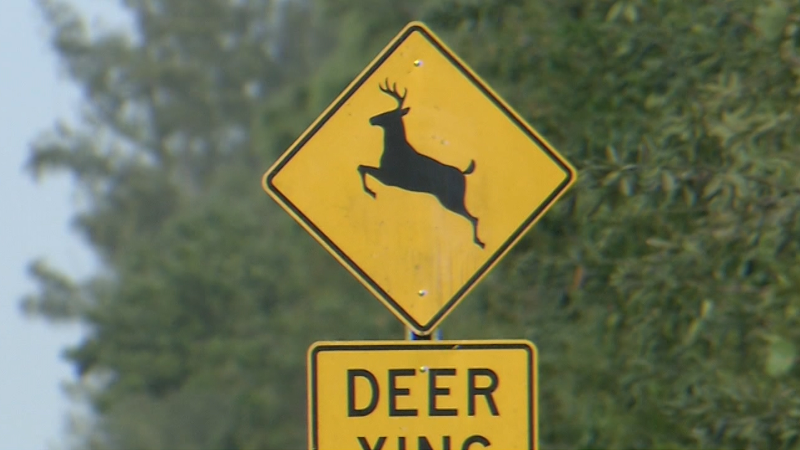Chicago Storm Analysis: Ralph`s Station
In the previous entry I quoted a blog reader as saying that his ears "popped" during the Chicago storms last night (Johnathan just put some excellent damage pictures online, by the way). To investigate why this happens, I've presented some graphs from Ralph's weather station (#CW6205) near Joliet, just outside of Chicago, along with a detailed meteorological explanation of what happened, below that.
LOCATION OF RALPH'S STATION | SEE IN GOOGLE EARTH
I selected Ralph's station because his had the most frequent observations (much better than the government airports) and because it showed the most impressive weather. Here's where the station is (looking ENE towards the city). Ralph's station is part of a nationwide network of amateur weather stations known as CWOP and displayed and plotted by MESOWEST (The Government Mesonet). If you have a weather station, join CWOP and your data will be used by meteorologists nationwide, including those here at AccuWeather.
So, on with the tutorial on last night's weather. Since I'm watching "Monk" in an hour this Friday night, please allow me to say...
"HERE'S WHAT HAPPENED..."
The first storm was heralded by a number of things. Like all strong thunderstorms, it had a Gust Front [WikiPedia] in front of it, that looked something like this time-lapse showing one racing towards my house. Gust fronts occur when cold air from high in a thunderstorm hits the ground and spreads out around the storm. This front carried a lot of wind with it, as evidenced by the spike to nearly 50 mph winds at 3:11 PM. As soon as the storm passes, the wind drops to dead calm.

| DOWNLOAD LOOP**
This high wind speed occurred simultaneously with a sharp temperature fall, from 86 to 70 degrees between 3:00 and 3:30 (the first part was about 7 degrees in 7 minutes, then we didn't hear from the station for another 22 minutes, so we could have actually seen that fall in half the time). This temperature fall occurred primarily because that wall of cold air from high in the thunderstorm overtook Ralph's location, and secondarily because it blacked out the sun and began to rain (when moisture increases in the air, temperature falls, something called "evaporative cooling" that we've discussed before as a winter travel hazard).
At this same time there was a severe, but smooth rise in pressure. This is a bit of a mystery, but since it doesn't correspond to the temperature fall (in the atmosphere, if pressure goes up, temperature generally goes down), I'm assuming it was the sheer force of the winds of the gust front piling up this air -- a "thunderstorm shock wave" if you will. Notice that when the gust front and rain has passed, the pressure falls at the same smooth rate, then resumes the more modest rate that it was falling before the storm (because a low pressure system, which caused the storms, was gradually moving towards Chicago from the west [map]).
A "rapid" pressure rise or fall is defined as 0.06" per hour or greater and is important enough that it must be noted on official meteorological observations [PDF]. This one was 0.09" up and down. Popping in human ears is caused by sudden pressure rises or falls (as you know if you've ever gone up, or down in a plane)*, but thresholds are different for different people; I would think anything over the meteorological definition of "rapid" could qualify.
During this time about a quarter of an inch of rain also fell, but this was nothing to compare with the second storm, which covered more area and moved slower.

The second storm was heralded by an increase in wind speed for nearly an hour before the gust front hit, and the pressure rise was extremely rapid and sudden, and would, for sure, cause your ears to pop. The pressure spiked 0.11" in 20 minutes (an equivalent of 0.33" per hour, over 5 times the definition of "rapid"). The pressure feel rapidly after the gust front passed through and, because the second storm was larger in area and had its own pressure fluctuations, it bounced around a bit after that.
The temperature fell a little, though barely past previous levels -- the cold air from high in the thunderstorms was about the same temperature when it reached the ground. But the rainfall was the impressive part with this second storm, spiking 0.71" of an inch in 12 minutes and 1.15" in one hour, blowing away the official meteorological definition of "heavy" rain [HTML] -- 0.30" per hour.
That, my friends, is exactly what happened at Ralph's weather station that fateful night of August 23, 2007.
*Planes don't regulate cabin pressure well because it's expensive. The reason your ears pop on a plane is because, although you're really going up 30,000 feet from the ground to flight-level, your ears only think you're going up 8,000 feet up and down (I have a barometer watch and have graphed out pressure falls and rises of over 100 mb during a plane ride -- more than 50 times the "rapid" definition shown above). A new luxury airliner called the Boeing 787 [WikiPedia] will feature higher pressure which will be somewhat better on your ears (the equivalent of 6,000 feet up and down).
**Quicktime required. "Save Target As" required for IE.
Report a Typo















